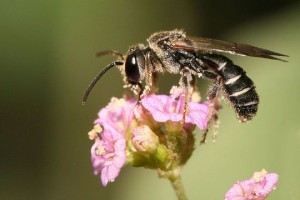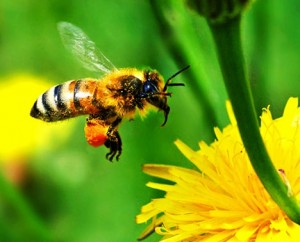 The name Sweat Bee, is a name given to a member of a large family of bees, who all have in common the fact that they are attracted to the salts in human perspiration. Sweat bees belong to the family
Halictidae
and most are small to medium-sized, 3 to 10 mm (0.12 to 0.40 ins) in length. They are generally black or metallic coloured and some are brilliant green or bright yellow. Sweat bees are among the most common bees and make up the majority, number wise, of bees wherever bees are to be found, except in Australia and Southeast Asia. There are about 1000 species in the United States, Canada and Central America alone and 20 in the UK.
The name Sweat Bee, is a name given to a member of a large family of bees, who all have in common the fact that they are attracted to the salts in human perspiration. Sweat bees belong to the family
Halictidae
and most are small to medium-sized, 3 to 10 mm (0.12 to 0.40 ins) in length. They are generally black or metallic coloured and some are brilliant green or bright yellow. Sweat bees are among the most common bees and make up the majority, number wise, of bees wherever bees are to be found, except in Australia and Southeast Asia. There are about 1000 species in the United States, Canada and Central America alone and 20 in the UK.
Because of their small size they are often mistaken for flies as they swarm sometimes in their hundreds over flowers in gardens or meadows, visiting a variety of plants. The different species are also often difficult to distinguish. The males often have a distinct yellow face, which is a common trait among many species of bees. They have extended hairy hind legs, which often make people mistake some of the bigger species for bumblebees. The hairs on their legs collect pollen which is carried back to the nest, while also pollinating the plants they visit.
Life Cycle
The life cycles of sweat bees vary tremendously among species. Most species nest in the ground, but some nest in wood. Nests usually consist of a single main tunnel having one or more clumped cells arising from lateral branches. A wide range of social development is displayed in the sweat bee family and many insights into the evolution of social behaviour among insects have been learned from sweat bees.
While all bumblebees and honeybees are social, sweat bees evolved (and are still evolving rapidly) sociality more recently and exhibit the full range of behaviour, from strictly solitary to strictly social species, with a queen and some workers. Many species are solitary, that is, the female builds and occupies its nest alone. This is considered the basic, most primitive nesting behaviour. In some sweat bee species, females nest communally, sharing a common nest entrance but constructing cells individually. Many species, including the common North American Eastern sweat bee, show varying levels of sociality, passing through a continuum of stages in social development. In these species, there may be several egg-laying ‘queens’ with the other nest mates functioning as workers. Sometimes generations of these bees overlap and live together and there may be a division of labour among nest mates. However, unlike many social bees, such as honey bees, there appears to be little communication between adults.
Of special interest are ‘socially polymorphic’ sweat bees, who take more than one social form within the same species. One of these the socially polymorphic sweat bee Halictus rubicundus is the subject of the study by Professor Field at the University of Sussex, England, in collaboration with colleagues at Queen’s University Belfast. In Britain and Ireland, northern or high-altitude populations of this bee are solitary, while southern, low-altitude populations of the same species are social.
The key experiment aimed to test whether individual bees could switch behaviour. The researchers transported bees between southern and northern locations, for example, from Belfast in Northern Ireland, where bees are always solitary, to warm and sunny Brighton on the English South Coast. The result was that the previously solitary bees switched to social behaviour. In the reverse experiment, southern, social bees became solitary when transplanted to Peebles in Scotland.
Professor Field says: “Sweat bee sociality is thought to occur only where the growing season is long enough to permit two annual broods. First, the queen must rear some workers. Then the workers must help to rear a second brood of new queens. A bee that finds itself too far North may not have a long enough summer to do this. Our findings suggest that individual bees adjust their strategies according to the time remaining for queen production: the earlier a nest produces its offspring, the more likely those offspring are to become workers. The queen may also have an influence, because more of her offspring become workers if she is still alive when they are born.”
He adds: “Origins of sweat bee sociality are linked with past episodes of climatic warming and sociality is today associated with warmer conditions. Rapid switching could thus help some sweat bees adapt to future warming and has probably allowed them to invade new biogeographic regions.”
Sweat Bees Sting
The males bite or pinch, while the females sting when pinched or removed roughly from the skin as it collects salt from our skin. The sting from a sweat bee however is much less painful than that from a honey bee.
Parasitic Sweat Bees
In some parasitic species of sweat bees, females invade the nests of other bees and lay their eggs in the food stored by the host bee. The sweat bee larva will then kill the host larva and consumes their food. The hosts are usually other species of sweat bees.
See also Alkali Bees

